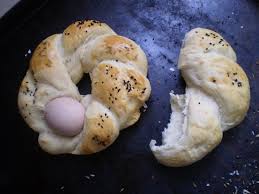Eid Bread – A Blidian Tradition of Joy

In Algeria, preparing Eid bread is among the most cherished traditions. It is a soft, brioche-style bread decorated with eggs.
Sometimes one egg is placed in the center. Other times, several colored eggs are used to brighten the festive bread.
This tradition carries joy and meaning for families. Moreover, it evokes childhood memories for children receiving it as a treat.
Eid Bread – Local Names and Regional Variations
In Amazigh, the bread is called Aghrum n Lεid or Tharthounth. In dialects, it is known as Rtouneh, Hloula, or Hnouna.
The Eid bread tradition remains alive in Blida, Cherchell, Miliana, and Tenes. It is passed down lovingly through generations.
These towns preserve the custom with pride. Furthermore, mothers and grandmothers often prepare it to create warm festive mornings.
Eid Bread – Ancient Roots and Mediterranean Links
This custom is very old, possibly older than Islam. It has parallels in many Mediterranean communities during spring celebrations.
Colored eggs were exchanged by ancient Egyptians more than 5,000 years ago. They symbolized renewal, optimism, and happiness.
Therefore, historians often highlight its cross-cultural value. Additionally, it shows how traditions connect families across cultures and religions.
Eid Bread – Special Names in Blida and Beyond
In Blida, people call it Khubz El Eid or Hniouna El Eid. The Amazigh word Thahnounth means “small bread.”
In Miliana and Cherchell, locals say Hnionat. In Tenes, the name changes to Artoun or Artouna.
Children often color eggs themselves. Alternatively, mothers prepare them, creating laughter and warmth on Eid mornings.
The Ingredients
To prepare soft Eid bread, simple ingredients are needed. You will need warm water, milk, instant yeast, and two eggs.
Other essentials include vegetable oil, sugar, salt, flour, and baking powder. Whole boiled eggs are used for decoration.
The dough should remain soft yet slightly sticky. Additionally, milk can replace water for a richer texture.
(for a soft, fluffy brioche-style Eid bread)
- 1 cup warm water
- 1 cup warm milk (or replace water with milk for a richer dough)
- 2 tbsp instant yeast
- 2 eggs
- ½ cup vegetable oil
- 1 tbsp sugar
- 1 tsp salt
- All-purpose flour (as needed, to form a soft dough)
- ½ packet baking powder (about 5–6 g)
- Whole eggs (boiled) – plain or dyed, for decoration
Eid Bread Recipe – Step by Step
Step 1 – Activate Yeast
Mix warm water, milk, and yeast. Leave it five minutes until activated.
Step 2 – Prepare Dough
Add eggs, oil, sugar, and salt. Gradually add flour and baking powder. Knead until smooth and elastic.
Step 3 – First Rise
Cover the dough with a towel. Let it rise thirty minutes or until doubled.
Step 4 – Shape Bread
Punch down the dough and shape loaves. Place boiled eggs, plain or dyed, in the center.
Step 5 – Bake
Brush with egg wash. Bake at 180°C for 20–25 minutes until golden brown.
Eid Bread – Tips and Variations
Milk can replace water to create a softer result. Furthermore, anise seeds or orange blossom water add authentic aroma.
Eggs can be dyed in bright colors for festive presentation. Consequently, the bread becomes both delicious and visually joyful.
This tradition still lives today. It must be preserved to honor identity, heritage, and collective memory.